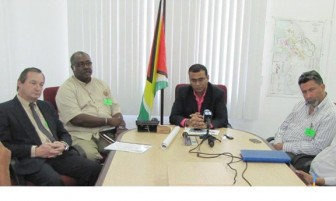With Repsol’s Atwood Beacon commencing drilling at the Jaguar – 1 site on Tuesday, CGX Energy Inc.’s Ocean Saratoga is expected to start drilling towards the end of next week, says Minister of Natural Resources and the Environment Robert Persaud.
“Drilling has started at the Jaguar – 1 well on Tuesday, all activities are proceeding as planned. It will take about six months to drill,” said the Minister at a press conference held at the Office of the President yesterday.
Further, he said that everything is going well at the Eagle well, the CGX 100 percent owned licence. The rig Ocean Saratoga is in position preparing for drilling at this well. Unlike the Jaguar well at 21,325 feet, the Eagle well is said to be much shallower and will be drilled to 14,200 feet and will take two months to reach that depth.

Asked about environmental safety for the both of the operations, Minister Persaud said that they have placed much emphasis on it. “We have been told that there is a robust plan that takes into consideration what has happened in the past,” he said. The Minister said too that there is a sector stakeholder workshop on Tuesday at which safety issues will be discussed. He noted that a team from the USA and from the Commonwealth will be coming to build capacity among the local stakeholders.
Mike Stockinger, the Chief Operations Officer (COO) of CGX Energy Inc said, “We have emergency plans and spill contingency plans in place.” Country Manager for Repsol Giancarlo Ariza was also present at the press conference.
So far Repsol has expended US$52 million on its exploration operations and this figure is expected to reach a total of US$180 million. The CGX operation at the Eagle well will cost the company some US$55 million. While the cost to operate the Ocean Saratoga will be US$500,000 per day, it will cost US$650,000 per day to operate the Atwell Beacon.
Minister Persaud said that the agreements between the companies and the Government have not changed and are in place. The Minister said that this phase of the operation is exploratory and said that interested parties must await the outcome of it before talking about production and its implications.
CGX President Stephen Hermeston said in a Marketwire press release “The spud of the Jaguar-1 well officially commences the long awaited resumption of offshore exploration drilling for the Government and People of Guyana, the Georgetown Joint Venture Partners and CGX shareholders. The Jaguar-1 well will be the deepest well drilled to date in the Guyana Suriname Basin. The well is targeting the Turonian geologic zone, a prolific producing zone offshore West Africa and Brazil”.
CGX had noted in an earlier release that the Eagle-1 well will be drilled on the Company’s 100% owned and operated Corentyne Petroleum Prospecting Licence, offshore Guyana. CGX says it will make a further announcement when the Eagle-1 well has commenced drilling.
Interest in the Guyana/Suriname basin amplified after explorer Tullow struck oil last year off of French Guiana raising the prospect of the opening of a major offshore oil producing province in South America and boosting its shares.
Tullow’s Zaedyus well in French Guiana, drilled in more than 2,000 metres of water and at a cost of some US$200 million, was tapping rock formations laid before Africa and South America separated millions of years ago, Reuters had reported.
The company, and partners Royal Dutch Shell Plc <RDSa.L>, with 45 percent and France’s Total with 25 percent, believed the oil-rich west African geology would be replicated in South America.
“Our Atlantic twin basin concept has proven to be valid,” Tullow’s exploration director Angus McCoss said on an investor call.
Tullow’s geological theory is not without precedent. In the past decade, fields with tens of billions of barrels of oil have been found offshore Brazil in reservoirs that were formed when the two continents were attached, Reuters said.
CGX has been attempting to drill offshore the Corentyne since June, 2000 when its contracted rig was chased out of the area by Surinamese gunboats. Protracted negotiations between Guyana and Suriname failed to yield agreement and there was no progress until Guyana took its case to the Law of the Sea Tribunal in Hamburg, Germany and won.




